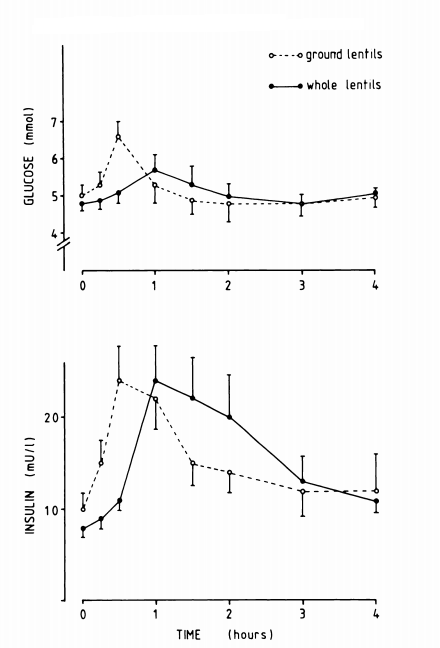The health benefits of legumes are numerous. These health benefits seems to stem from the ability of legumes to produce beneficial glycaemic effects. In other words legumes can lower the rate at which the carbohydrate content of the gut is able to enter the blood and this lowers the rise in insulin seen postprandially. Legumes are therefore an ideal weight loss food because it is a lack of control of blood sugar and insulin that is a primary driver of the insulin resistance that causes weight gain. One way that whole plant foods are thought to reduce the rate of carbohydrate absorption is via a reduction in the rate of starch hydrolysis. This occurs because plants contain carbohydrate within cellulose cell walls, the cellulose component being non-digestible to humans. The presence of intact or semi-intact cells walls therefore acts as a barrier to starch digestion and this slows the rate of absorption. Such a mechanism appears to play an important role in controlling the rate of starch digestion from cereal grains.
Compared to grains, legumes show delayed rises in postprandial blood sugar levels. However, in legumes the rate of starch hydrolysis might not play such an important role in controlling the rise in insulin levels. For example, in one study1, researchers measured the rate of starch hydrolysis in both intact and ground lentils using an in vitro digestion model where they simulated the conditions of the gut. In this case, the ground lentils had starch digestion rates that were 5-fold greater when compared to the whole lentils suggesting that the presence of intact cell walls does indeed protect the starch contained within from digestion by pancreatic amylase. However, when the authors then gave either ground or whole lentils to human subjects they found that the ground lentils produces a blood sugar rise that peaked at 30 mins, whereas the whole lentils produced a blood sugar rise that was more gradual and peaked at 60 min. However there was no difference in the magnitude of the insulin responses to either ground or whole lentils (figure 1).

Figure 1. Top: the rise in blood sugar levels of ground or whole lentils. Bottom: the rise in insulin levels in ground and whole lentils.
Surprisingly in this study, despite the peak glucose response being considerably greater for ground lentils, the peak insulin responses were very similar. These results suggest that factors other than starch hydrolysis rates are important in determining the insulin rises caused by lentils. Other studies suggest that this may be true for other important dietary pulses including beans and peas. These results are in contrast to those seen with rice for example, where grinding the rice finely before consumption caused an increase in both blood glucose and insulin responses that mirrored the increase in in vitro starch digestion rates. Ground lentils therefore appear to elicit a reduced metabolic response compared to what might be predicted from rice studies and from their own in vitro digestion rates. One explanation for this might be that the high protein content of lentils is able modify insulin release in some way perhaps through delayed gastric emptying. Alternatively, the fibre within the lentils may form a physical barrier to glucose absorption.
Dr Robert Barrington’s Nutritional Recommendation: Legumes are high quality foods that show beneficial effects at protecting from Western lifestyle diseases. Legumes should form the cornerstone of any healthy diet, and be used to obtain high quality slow release starch. In this regard they are particularly beneficial to those wishing to lose weight, because aberrations in blood sugar control are now heavily implicated in weight gain and the development of obesity. The high protein content and fibre content of legumes may be the reasons they have beneficial glycaemic effects but how these factors interact is not fully understood.
RdB
